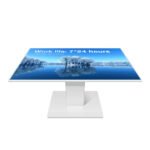LCD vs LED: Which Display Wins for Digital Signage?
Is choosing the right display technology for your next digital signage project giving you a headache? For businesses aiming to capture customer attention and deliver dynamic content, the foundational decision often boils down to a thorough LCD vs LED comparison. In the high-stakes world of digital out-of-home (DOOH) advertising, the display you select is not just a screen; it’s the core of your communication strategy, directly impacting visibility, operating costs, and content impact. This in-depth guide is tailored for digital signage product users and decision-makers, offering a professional, practical analysis of these two dominant technologies, ensuring you make an informed choice that delivers maximum value and return on investment.
Understanding the Foundational Technology: A Digital Signage Perspective

Before pitting one technology against the other, it’s crucial to understand what these acronyms represent and how they function in the digital signage environment.
LCD stands for Liquid Crystal Display. In simplest terms, an LCD screen doesn’t produce its own light. Instead, it relies on a separate light source—a backlight—to illuminate the image. Historically, this backlight was made of Cold Cathode Fluorescent Lamps (CCFLs), but modern, high-performance digital signage LCDs predominantly use an LED backlight. This distinction is critical: when we discuss a modern commercial LCD, we are often talking about an LED-backlit LCD, or what is sometimes confusingly just called an “LED display” by the general public. The liquid crystals themselves act like tiny shutters, opening and closing to allow varying amounts of light from the backlight through colored filters to form the final image.
LED stands for Light Emitting Diode. Conversely, a true LED display, particularly in the context of large-format digital signage, is a direct-view LED or DV-LED screen. In this technology, the LEDs are the pixels; they directly emit light and form the image. These displays are built from modular cabinets seamlessly tiled together to create massive, virtually bezel-less video walls. It is this direct-view nature that grants true LED technology many of its key advantages in the digital signage space.
The Great Divide: Key Differences in Performance and Application

When evaluating LCD vs LED for digital signage, the comparison must move beyond simple functionality to focus on the performance metrics that truly matter for commercial use: brightness, contrast, size scalability, and lifespan. The differences here are not merely technical; they dictate where and how each technology can be effectively deployed.
Brightness and Visibility: Battling the Elements
For outdoor and semi-outdoor digital signage, brightness is the single most important factor. Direct sunlight can easily wash out a screen with lower luminosity.
- LCD (LED-Backlit): While commercial-grade LCD panels can achieve impressive brightness levels (often up to 3,000-4,000 nits for outdoor use), they are inherently limited by the power of the backlight. Achieving extreme brightness often requires sacrificing panel longevity and generates significant heat. The light must also pass through polarizing filters and liquid crystals, leading to some light loss.
- LED (Direct-View): True LED displays are undisputed champions of brightness, easily reaching 6,000 to over 10,000 nits. Since the LEDs emit light directly, they can generate far more intensity, making them fully visible even in direct, midday sunlight. Consequently, for large, high-impact outdoor billboards and stadium screens, the LED display is the superior, often mandatory, choice.
Contrast and Image Quality: Depth and Vibrancy
A display’s ability to show deep blacks and bright whites—its contrast ratio—is fundamental to image quality and impact.
- LCD: Contrast is constrained because some light from the backlight inevitably leaks through the liquid crystal shutters, preventing a “perfect black.” While local dimming (turning off sections of the backlight) has improved this, the inherent structure means blacks tend to appear dark gray.
- LED: With direct-view LED technology, individual pixel clusters can be turned completely off, resulting in a theoretically infinite contrast ratio and truly deep, rich black levels. This capability translates into stunningly vibrant and dynamic visuals, especially when displaying high dynamic range (HDR) content. The image quality, particularly the color depth and uniformity, is noticeably superior to an LCD.
Scalability and Bezel: Design Without Limits
Digital signage often requires flexible sizing and the ability to create seamless visual experiences.
- LCD: LCD panels are constrained by their fixed factory size. When combined into a video wall, the structural frames surrounding each panel create a visible bezel (a black line), which breaks up the image. While ultra-narrow bezel LCDs minimize this distraction, the line remains an unavoidable limitation, making them less ideal for continuous, large-scale imagery where the content flows uninterrupted.
- LED: The modular nature of direct-view LED panels allows them to be tiled seamlessly, virtually eliminating any bezel. This is arguably one of LED’s biggest selling points, allowing for the creation of giant, uniquely shaped, and truly custom-sized video walls that can fill entire building facades or reception areas, offering unparalleled creative freedom.
Cost and Total Cost of Ownership (TCO): The Business Reality

The initial price tag is only one part of the financial equation; the Total Cost of Ownership (TCO) over the display’s lifetime must be carefully considered.
Initial Investment and Pixel Pitch
The initial capital expenditure for a high-quality commercial LCD panel is significantly lower than for a direct-view LED display of comparable size. The cost of LED is heavily influenced by the pixel pitch (the distance between LED clusters in millimeters). A smaller pixel pitch offers a higher resolution but comes with a substantially higher price tag. Therefore, for standard indoor applications like in-store advertising or menu boards where viewing distances are relatively close and size is manageable, an LCD panel typically offers the most cost-effective solution.
Longevity and Maintenance
Both technologies offer long operational lifespans, often rated for 50,000 to 100,000 hours. However, maintenance approaches differ.
- LCD: When an LCD panel fails, the entire unit usually needs replacing. The backlight life often dictates the usable lifespan, and over time, the color and brightness uniformity of the panel can degrade, necessitating replacement to maintain brand standards.
- LED: A major advantage of modular LED video walls is that individual cabinets or even single LED modules can be replaced, often from the front, without disturbing the entire structure. This modular repairability drastically reduces long-term maintenance costs and downtime, improving the TCO for very large installations.
Power Consumption and Environmental Impact
Generally speaking, a direct-view LED display consumes more power than an LED-backlit LCD of the same size and resolution, primarily due to the intense brightness potential of the LED. This high power draw translates into higher ongoing electricity bills and necessitates more robust cooling infrastructure, which must be factored into the overall TCO, especially for large, always-on deployments. Conversely, newer, common cathode and micro-LED technologies are continuously pushing the envelope to reduce the power consumption of LED displays.
Strategic Application: Where Each Technology Shines
The choice between LCD vs LED is ultimately an application-driven one. There isn’t a single “best” technology; there is only the best-fit technology for a specific environment and business objective.
In conclusion, for many everyday indoor digital signage needs where cost and pixel density are priorities, the highly refined LCD (LED-backlit) technology remains an extremely competitive and sensible choice. However, when the requirement is for maximum size, flawless visual continuity, extreme brightness, and unparalleled impact—such as in architectural media or high-end retail flagship stores—the direct-view LED display stands alone as the dominant and indispensable solution. Digital signage users must, therefore, weigh the initial investment against the application’s demands for brightness and scalability to secure a platform that will truly elevate their brand message.
Frequently Asked Questions (FAQ)
Q: Is an “LED TV” the same as a “Direct-View LED” screen for digital signage?
A: No, they are fundamentally different. A typical “LED TV” is actually an LCD display that uses an LED backlight (hence the name LED-backlit LCD). A Direct-View LED screen, used for professional digital signage, uses the LEDs themselves as the image-forming pixels and does not require a separate backlight or liquid crystal layer.
Q: How is the resolution of an LED video wall determined?
A: The resolution of a Direct-View LED video wall is determined by its pixel pitch (the distance between LED clusters). A smaller pixel pitch (e.g., 1.5mm) means more pixels packed into a smaller space, resulting in a higher resolution and higher cost. The total resolution is calculated based on the pitch and the physical size of the wall.
Q: What is the main benefit of “narrow-bezel” LCD video walls?
A: Narrow-bezel LCD video walls minimize the black line (bezel) that separates individual panels, making the transition between screens less noticeable. While they offer a good compromise for budget-conscious video walls, they can never achieve the truly seamless, bezel-free look of a direct-view LED display.




